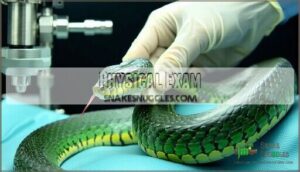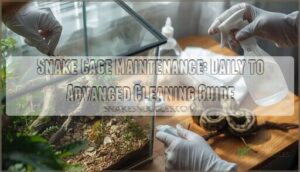This site is supported by our readers. We may earn a commission, at no cost to you, if you purchase through links.

Start by contacting an exotic veterinarian immediately – they’ll prescribe systemic antibiotics to fight the infection. You’ll also need to crank up the heat in your snake’s basking area to boost their immune system.
Fluid therapy helps prevent dehydration, while nutritional support keeps their strength up during recovery. Think of it like giving your snake every weapon possible to win this battle.
The key is catching it early and being aggressive with treatment – waiting around isn’t an option here.
Table Of Contents
- Key Takeaways
- Causes of Snake Septicemia
- Symptoms of Snake Septicemia
- Diagnosing Snake Septicemia
- Treatment Options for Snake Septicemia
- Managing Snake Septicemia
- Preventing Snake Septicemia
- Complications of Snake Septicemia
- Living With Snake Septicemia
- Future Research and Development
- Frequently Asked Questions (FAQs)
- What is the best treatment for septicemia?
- Can septicemia go away by itself?
- How do you treat septicemia in animals?
- Can you heal from septicemia?
- What causes septicemia in reptiles?
- How do you treat a snake infection?
- How do you get rid of a respiratory infection in a snake?
- How do you treat crypto in snakes?
- How long does snake septicemia last?
- Can snake septicemia be cured?
- Conclusion
Key Takeaways
- Act fast with veterinary care – You need to contact an exotic vet immediately, since septicemia can kill your snake quickly, and early treatment with systemic antibiotics dramatically improves survival rates.
- Boost your snake’s immune system – You will want to increase the basking temperature and provide proper nutrition to help your snake fight the infection more effectively.
- Maintain a spotless environment – You must keep the enclosure extremely clean during treatment, removing waste immediately and disinfecting regularly to prevent reinfection.
- Commit to long-term monitoring – You will need regular vet visits and ongoing care, since some snakes develop chronic infections or complications that require lifelong management.
Causes of Snake Septicemia
Understanding what causes snake septicemia helps you protect your pet from this serious blood infection.
Several factors can trigger septicemia, from wounds and dirty tanks to stress and poor feeding habits.
Localized Infections
Localized infections act as dangerous gateways for snake septicemia.
Small wounds can quickly become deadly highways for bacteria to invade your snake’s bloodstream.
When bacteria invade wounds, bites, or abscesses, they can quickly spread throughout your snake’s bloodstream if left untreated.
Here’s how to prevent these infections:
- Wound Care – Clean injuries immediately with saline solution and monitor healing progress
- Bite Infections – Examine feeding wounds and separate aggressive cage mates promptly
- Abscess Formation – Watch for swollen, warm areas that need veterinary drainage
- Early Detection – Check your snake weekly for cuts, scrapes, or unusual skin changes
Swift action prevents minor issues from becoming life-threatening emergencies.
Traumatic Injuries
How do traumatic injuries turn your snake’s world upside down? When your snake gets hurt from sharp cage decorations, rough handling, or fighting with cage mates, those wounds become bacterial highways.
Wound Management requires immediate attention—clean injuries with reptile-safe antiseptics and monitor closely. Enclosure Safety means removing hazards that cause trauma.
Injury Severity determines Trauma Response—minor cuts need basic wound care, while deep wounds risk bacterial infection leading to snake septicemia treatment with snake antibiotics.
Bite Prevention through proper handling protects your scaled friend from becoming septicemia’s next victim.
Parasite Infestations
Parasite infestations weaken your snake’s immune system, making septicemia more likely.
Mites and ticks are common external parasites that damage skin and create entry points for bacteria.
These tiny bloodsuckers also carry harmful microorganisms through mite transmission and tick vectors.
Internal parasites like hookworms cause serious problems too.
They attach to your snake’s intestinal walls, creating wounds that allow bacteria to enter the bloodstream.
The hookworm impact can be devastating if left untreated.
Protozoal infections add another layer of complexity, weakening your pet’s defenses against bacterial invasion.
When parasites compromise your snake’s health, snake antibiotics become necessary for reptile infection treatment.
Parasite prevention is your best defense.
Regular veterinary checkups help catch infestations early.
Your vet can recommend proper snake septicemia treatment if needed.
Clean enclosures and quarantining new animals reduces parasite risks substantially.
Dirty Environments
Your snake’s home can become a breeding ground for dangerous bacteria if you don’t stay on top of enclosure sanitation. Dirty environments create perfect conditions for septicemia in snakes to develop, making bacteria control essential for your pet’s health.
Here are five critical steps for maintaining proper hygiene protocols:
- Remove uneaten food within 24 hours to prevent bacterial growth
- Spot-clean waste immediately using appropriate disinfectant use methods
- Replace substrate weekly or when visibly soiled
- Scrub water bowls with reptile-safe cleaners twice weekly
- Deep-clean the entire enclosure monthly with proper ventilation
Think of your snake’s enclosure like your kitchen – you wouldn’t leave dirty dishes sitting around for weeks. Proper cleaning requires the right snake habitat products. The same principle applies to treating snake infection prevention. Regular waste removal and consistent cleaning schedules dramatically reduce reptile septicemia risks, keeping your scaly friend healthy and happy.
Improper Feeding
Your snake’s meals can become a gateway for harmful bacteria if you’re not careful about what and how you feed them. While a clean enclosure helps prevent infection, the food itself can introduce dangerous microorganisms directly into your pet’s system.
Live Prey Risks top the list of feeding problems that lead to septicemia in snakes. When you offer live rodents or other prey, you’re basically inviting gut bacteria and potential food contamination into your snake’s world.
Here’s what goes wrong:
- Unbalanced Diets weaken your snake’s immune system, making them vulnerable to treating snake infection scenarios that could’ve been avoided
- Nutritional Deficiencies from poor-quality or expired food create the perfect storm for bacterial overgrowth
- Contaminated prey items carry harmful bacteria that enter through your snake’s digestive tract, potentially causing snake septicemia
Frozen-thawed prey eliminates most bacterial risks while providing proper nutrition. You’ll want to source food from reputable suppliers and store it correctly. Remember, antibiotics can’t fix what proper feeding prevents.
Inadequate Temperature and Humidity
Your snake’s environment acts like a thermostat for their health. Inadequate temperature and humidity levels create perfect conditions for septicemia in snakes.
Looking at this comprehensive article about snake septicemia, here’s an engaging blockquote that captures the essence of environmental control:
**Perfect temps and humidity aren’t luxury—they’re your snake’s lifeline against deadly septicemia.
Without proper temperature effects, your snake can’t regulate their immune system effectively, leading to immune suppression.
Poor humidity impact causes shedding problems and respiratory issues, while incorrect temperatures weaken their natural defenses.
Treating reptile septicemia becomes necessary when environmental conditions aren’t maintained properly, making your snake vulnerable to bacterial infections that enter through compromised skin or respiratory systems.
Stress
When you don’t manage stress properly, your snake becomes vulnerable to septicemia in snakes.
Poor handling techniques, cramped enclosure design, and lack of environmental enrichment trigger immune suppression.
Your snake can’t fight off bacteria when constantly stressed from overcrowding, excessive noise, or rough handling.
Smart stress reduction methods like gentle interactions and proper habitat setup strengthen your pet’s natural defenses against snake septicemia.
Symptoms of Snake Septicemia
Recognizing septicemia symptoms early can save your snake’s life since this blood infection progresses rapidly without treatment.
You’ll notice signs like difficulty breathing, extreme tiredness, seizures, muscle weakness, and red patches on your snake’s belly that signal serious trouble.
Difficulty Breathing
Breathing troubles can sneak up fast when your snake develops septicemia.
You’ll notice respiratory distress as one of the first warning signs that something’s seriously wrong.
Watch for these critical symptoms:
- Open-mouth breathing or gasping for air
- Wheezing sounds during normal activity
- Rapid breathing that seems labored or forced
Lethargy
When your snake seems sluggish or unresponsive, lethargy signals that septicemia may be affecting their entire system.
This exhaustion happens as bacteria overwhelm their body, making even basic movements feel impossible.
| Energy Level | Normal Snake | Lethargic Snake |
|---|---|---|
| Movement | Active, alert responses | Slow, minimal motion |
| Feeding | Enthusiastic appetite | Refuses food completely |
| Interaction | Curious about environment | Ignores surroundings |
Diagnosing lethargy requires veterinary care since treating lethargy depends on identifying the underlying infection.
Managing lethargy involves antibiotics and supportive care, while preventing lethargy means maintaining proper husbandry to avoid snake septicemia altogether.
Convulsions or Seizures
Occasionally, snakes with septicemia develop convulsions or seizures that signal serious neurological damage from the bacterial infection.
These episodes can range from mild muscle twitching to full-body convulsions, with seizure severity often indicating how far the disease has progressed.
When bacteria invade the bloodstream, toxins can cross into the brain and nervous system, causing these frightening neurological symptoms.
Different convulsion types may appear – from localized tremors to generalized seizures that affect your snake’s entire body.
Some snake breeds, such as spider ball pythons, are prone to head wobbling.
- Emergency Response: If your snake experiences seizures, contact a reptile veterinarian immediately, as neurological symptoms indicate advanced septicemia requiring urgent intervention.
The long-term prognosis depends on how quickly you seek veterinary care and begin antibiotics treatment.
Some snakes recover completely with prompt medication effects, while others may experience lasting neurological issues.
Snake disease treatment for septicemia in snakes focuses on controlling the infection before permanent damage occurs.
Your vet will assess snake symptoms and determine the most effective antibiotics based on the specific bacteria involved.
Weakness or Inability to Move
After convulsions, you might notice your snake lying still, barely moving, or struggling to slither.
This weakness can signal Muscle Atrophy or even early signs of Paralysis Causes from septicemia in snakes.
Nerve Damage from the infection makes it tough for your pet to get around.
Supportive Care and Mobility Aids, plus antibiotics, are essential parts of snake disease treatment.
Loss of Muscle Control
One telltale sign involves watching your snake’s movement coordination deteriorate. Nerve damage from septicemia disrupts normal muscle function, creating obvious warning signs that demand immediate veterinary attention.
- Wobbly movements – Your snake can’t maintain steady control
- Strike coordination problems – Missing targets or jerky motions
- Paralysis causes – Complete loss of movement in severe cases
- Muscle atrophy – Weakening from systemic infection requiring supportive care
Reddish Discoloration of The Ventral Skin
The most telling sign of snake septicemia is a reddish discoloration along your snake’s belly, known as septic blush.
This diagnostic significance comes from small blood vessels bursting under the skin, creating distinctive discoloration patterns that indicate blood infection snakes are experiencing.
These snake infection signs appear as red or purple patches, making septicemic snake symptoms easy to spot.
Without prompt antibiotics treatment, this prognostic indicator signals serious snake septicemia requiring immediate veterinary attention.
Diagnosing Snake Septicemia
When you suspect your snake has septicemia, getting the right diagnosis becomes critical for effective treatment.
Your veterinarian will use several diagnostic methods including physical examination, blood tests, imaging, and bacterial culture to confirm the infection and identify the specific bacteria causing the problem, which is essential for effective treatment.
Physical Exam
When recognizing septicemic snake symptoms, your vet will conduct a thorough physical exam to assess your snake’s overall health.
This hands-on evaluation provides essential clues about your pet’s condition and guides further diagnostic steps.
During the veterinary care session, your vet will systematically examine:
- Key signs and hydration status – checking body temperature, respiratory rate, and skin elasticity
- Skin assessment and palpation findings – looking for discoloration, swelling, or unusual textures
- Neurological exam responses – testing reflexes and muscle control for snake septicemia indicators.
This thorough snake vet care approach helps identify specific symptoms and determine the severity of your snake’s condition before proceeding with additional diagnosis methods.
Septicemia is a significant concern, often stemming from underlying bacterial infections.
Blood Work
Blood work reveals the true story of what’s happening inside your snake’s body during septicemia.
Your vet will run blood tests including blood cell count and blood chemistry analysis to spot bacterial infection markers.
Culture sensitivity testing identifies the exact bacteria causing trouble, while checking for electrolyte imbalance and organ function markers guides treatment decisions for your snake’s recovery.
Imaging Techniques
Imaging techniques like radiography and ultrasound help veterinarians peek inside your snake’s body to spot hidden infections.
These tools reveal internal abscesses, organ swelling, and fluid buildup that blood tests might miss.
- X-rays show bone changes and organ enlargement
- Ultrasound imaging detects fluid-filled pockets and soft tissue problems
- CT scans provide detailed cross-sectional views for precise diagnosis
Bacteriology
Why do vets take blood cultures when diagnosing snake septicemia?
These culture techniques help identify specific bacterial strains in the bloodstream and test for antibiotic resistance.
Pathogen identification through bacteriology guides treatment decisions, preventing bacterial growth and controlling bacterial transmission.
Understanding which bacterial infection causes your snake’s septicemia guarantees targeted therapy for better recovery outcomes.
Treatment Options for Snake Septicemia
When your snake develops septicemia, quick treatment makes the difference between life and death.
You’ll need to work closely with a reptile veterinarian who can prescribe the right combination of antibiotics, supportive care, and environmental adjustments to fight this serious blood infection.
Systemic Antibiotics
Once you’ve confirmed septicemia through proper diagnosis, systemic antibiotics become your snake’s lifeline against bacterial infection.
You’ll need to work with your vet to determine the right antibiotic types and dosage calculation for your snake’s weight and condition. Injectable antibiotics often work faster than oral antibiotics, but administration methods depend on your snake’s specific needs.
Reptiles experiencing septicemia may also exhibit signs of sepsis, such as lethargy or anorexia.
Here’s what you need to know about antibiotic treatment:
- Antibiotic Types – Common choices include enrofloxacin and amoxicillin-clavulanate for snake systemic infection
- Dosage Calculation – Your vet calculates precise amounts based on your snake’s body weight
- Administration Methods – Injectable or oral routes, with injections often preferred for severe cases
- Treatment Duration – Courses typically last 2-4 weeks to prevent resistance development
- Monitoring – Regular check-ups confirm the septicemia snake responds properly to treatment
Fluid Therapy
Your snake needs fluid therapy to combat dehydration and maintain proper electrolyte balance during snake septicemia.
Vets use various administration routes and fluid types based on severity.
Monitoring hydration levels helps determine the right treatment approach.
This supportive care works alongside antibiotics to manage your snake systemic infection effectively.
Nutritional Support
While fluid therapy helps stabilize your snake’s condition, proper nutritional support plays a key role in recovery from septicemia.
Your snake’s immune system needs fuel to fight infection, but appetite often disappears when they’re sick.
Here’s how to support your snake nutritionally:
- Force-Feeding Techniques: Work with your vet to safely tube-feed if your snake won’t eat voluntarily
- Dietary Supplements: Add vitamins and probiotics to support gut microbiome health during antibiotic treatment
- Hydration Strategies: Monitor water intake closely since dehydration worsens septicemia outcomes
Appetite stimulants might help jumpstart eating, but don’t expect miracles overnight.
Think of nutritional support as building blocks – each meal helps repair tissue damage and strengthens defenses against secondary infections.
Your veterinary care team will guide feeding schedules and supplement choices based on your snake’s specific needs.
Warm Basking Site
Your snake needs a proper warm basking site to boost its immune system and fight septicemia. Think of it as creating a healing sanctuary where your pet can regulate body temperature and recover effectively.
- Temperature Gradient: Maintain basking spots at 88-95°F (31-35°C) with cooler areas nearby for thermoregulation
- Placement: Position heat sources away from direct sunlight to prevent dangerous overheating episodes
- Site Materials: Use ceramic heat emitters or basking lamps to provide consistent, focused warmth
Consider reliable heat sources for proper reptile care.
- Monitoring Temperature: Check temperatures daily with reliable thermometers to verify therapeutic heat levels
Proper basking benefits include enhanced immune function, improved circulation, and better antibiotic absorption. This simple snake treatment option substantially supports recovery from bacterial infections.
Surgical Intervention
When your snake’s septicemia requires surgical intervention, you’re facing serious treatment options that demand careful consideration.
Surgery becomes necessary when abscesses need drainage, infected tissue requires removal, or foreign bodies must be extracted.
Here are three key surgical procedures your vet might recommend:
- Abscess Drainage: Removing infected pockets of fluid to reduce bacterial load and improve antibiotic effectiveness
- Wound Debridement: Cutting away dead or infected tissue to promote healthy healing and prevent further spread
- Tissue Repair: Reconstructing damaged areas while addressing amputation risks in severe cases
Remember, surgical intervention works best alongside antibiotics and supportive care for ideal snake septicemia treatment outcomes.
Managing Snake Septicemia
Once you’ve started antibiotic treatment, managing your snake’s recovery requires careful attention to its environment and overall health.
You’ll need to create the perfect healing conditions while monitoring your pet’s progress closely.
Providing a Clean Environment
Beyond providing proper antibiotics and supportive care, maintaining enclosure hygiene plays a major role in your snake’s recovery from bacterial infection. Clean surroundings help prevent reinfection and support healing.
Enclosure Disinfection should happen weekly using reptile-safe cleaners. Remove your snake first, then scrub all surfaces, decorations, and hiding spots. It’s like giving your snake’s home a fresh start.
Substrate Choice matters more than you’d think. Paper towels or newspaper work best during recovery – they’re easy to replace and don’t harbor bacteria like wood chips might.
Waste Removal needs immediate attention. Snake droppings and uneaten food create bacterial playgrounds, so clean them up right away.
Water Quality requires daily attention. Fresh, clean water prevents additional bacterial exposure.
Here are key steps for proper snake care during septicemia treatment:
- Replace substrate immediately when soiled
- Disinfect water bowls daily with diluted bleach solution
- Quarantine protocols keep infected snakes separate from healthy ones
- Monitor enclosure humidity to prevent bacterial growth
Clean environments speed recovery substantially.
Maintaining Proper Humidity and Temperature
Temperature control acts like your snake’s thermostat for fighting snake septicemia.
Create a temperature gradient from 75°F to 90°F with proper humidity between 40-60%.
Poor temperature control causes shedding problems and weakens respiratory health.
Use environmental monitoring tools like digital thermometers and hygrometers. Proper setup requires a snake’s specific equipment.
Consistent warmth helps antibiotics work better during treatment. Think of it as creating a cozy recovery room for your scaly friend’s healing journey.
Reducing Stress
When stress runs high, your snake’s immune system takes a hit, making snake septicemia more likely.
Minimizing handling techniques and creating quiet environments help tremendously. Provide enclosure enrichment like hiding spots and climbing branches to reduce social isolation effects.
Maintain consistent lighting schedules to avoid disrupting natural rhythms. Focus on noise reduction around the habitat—loud sounds stress reptiles out.
These stress reduction methods work alongside antibiotics, fluid therapy, and nutritional support to boost recovery chances substantially, and can be considered as part of a broader approach to recovery chances.
Improving Immune Function
Boosting your snake’s immune function acts like building a fortress against septicemia and other infections.
A strong immune system helps your pet fight off harmful bacteria before they spread through the bloodstream. When combined with proper antibiotics and nutritional support, enhanced immunity speeds recovery and prevents future episodes.
Your snake’s gut microbiome plays a huge role in immune health. Here’s how to strengthen their natural defenses:
- Probiotic use: Add beneficial bacteria through specialized reptile probiotics to support digestion and immune response
- Vitamin supplements: Provide essential nutrients like vitamin A and D3 that boost immune cell production
- Stress reduction: Keep handling minimal and maintain consistent routines since chronic stress weakens immunity
- Hydration importance: Make certain fresh water availability as dehydration compromises immune function rapidly
- Optimal nutrition: Feed high-quality prey items with proper calcium-to-phosphorus ratios for cellular health
Think of immune support as preventive medicine—it’s easier than treating full-blown septicemia later. **A clean enclosure is essential for immune support.
Preventing Snake Septicemia
You can prevent snake septicemia by maintaining excellent husbandry practices and staying alert to your snake’s health needs.
Think of prevention as building a fortress against infection – proper feeding, regular vet visits, spotless environments, and stress reduction create multiple barriers that keep harmful bacteria at bay, which is key to prevention.
Proper Feeding and Nutrition
A well-balanced diet acts as your snake’s first line of defense against septicemia. Poor nutrition weakens the immune system, making your pet vulnerable to bacterial infections that can quickly turn deadly.
Live Prey Risks pose significant dangers. Fresh-killed or frozen-thawed prey reduces bacteria exposure compared to live animals that might carry harmful pathogens. Always source prey from reputable suppliers who maintain proper hygiene standards.
Your feeding strategy should include these essentials:
- Balanced Snake Diets with appropriately-sized whole prey items (rodents should be 10-15% of your snake’s body weight)
- Feeding Frequency every 7-14 days for adults, adjusting based on species and body condition
- Nutritional Supplements like calcium dusting for growing snakes or those with deficiencies
- Water Quality maintenance with clean, dechlorinated water changed weekly
Monitor your snake’s appetite and digestion carefully. Regurgitation or prolonged food refusal signals potential health issues requiring veterinary attention. Remember, proper nutrition supports natural antibiotic resistance and reduces the need for medical interventions like fluid therapy later.
Regular Veterinary Check-Ups
Beyond proper nutrition, Early Detection through Preventative Care becomes your next line of defense.
Schedule biannual veterinary visits for Health Monitoring and blood tests to catch infections before they become septicemia.
Your Expert Advice from a reptile specialist provides Cost Savings by preventing expensive emergency treatments.
| Veterinary Visit Schedule | What Your Snake Gets |
|---|---|
| Every 6 months | Parasite screening, physical exam |
| Annual checkup | Blood work, antibiotics if needed |
| Emergency visits | Immediate snake veterinary care |
Think of it like insurance for your scaly friend’s health.
Maintaining a Clean and Well-Maintained Environment
Beyond regular vet visits, your snake’s living space needs consistent attention to prevent bacterial infections. Think of it like keeping your own home clean – neglect leads to problems.
Enclosure hygiene starts with these three key steps:
- Daily waste removal – Remove uneaten food and feces immediately to stop bacteria from multiplying
- Weekly disinfection protocols – Use reptile-safe cleaners like diluted bleach solutions to eliminate pathogens
- Monthly deep cleaning – Replace substrate and scrub all surfaces thoroughly
Your substrate choice matters too. Avoid materials that hold moisture, which creates perfect breeding grounds for harmful bacteria. Paper towels or aspen shavings work well and make regular cleaning easier.
Water quality can’t be overlooked either. Change water every few days and clean bowls weekly. Poor hygiene practices turn your snake’s home into a bacterial playground, making septicemia more likely.
Reducing Stress and Trauma
A clean environment sets the foundation, but your snake’s mental state matters just as much.
Stress weakens their immune system and makes them sitting ducks for snake septicemia.
Think of stress as opening the door for trouble.
Your snake doesn’t need daily drama.
Here’s how to keep them zen:
Safe Handling: Move slowly and support their body.
No sudden movements that’ll spook them.
Let them settle after meals before any handling sessions.
Enclosure Design: Create a snake sanctuary with proper hiding spots, climbing branches, and temperature gradients.
They need their own private retreat.
Enrichment Activities: Rotate decorations occasionally and provide different textures.
Boredom leads to stress in captivity.
Social Isolation: Most snakes prefer the single life.
Don’t house different species together unless you’re asking for territorial disputes.
Trauma prevention starts with smooth handling techniques and removing sharp objects from their space.
A relaxed snake is a healthy snake, and that’s your best defense against septicemia.
Complications of Snake Septicemia
When septicemia progresses without proper treatment, your snake can face serious complications that threaten its survival.
These complications include organ failure, secondary infections, and lasting health problems that can affect your pet’s quality of life even after recovery, potentially leading to lasting health problems.
Organ Failure
When organ failure strikes, your snake’s liver and kidneys can’t handle the toxic overload from snake septicemia.
Kidney damage and liver failure happen fast, while heart complications and respiratory distress follow close behind.
The neurological impact can leave your snake weak and confused.
Antibiotics and aggressive treatment options might help, but septic shock makes recovery tough.
Supportive care, including fluid and nutritional support, can also aid recovery.
Secondary Infections
Secondary infections strike when your snake’s immune system can’t fight back.
These opportunistic invaders include fungal infections, parasitic overload, and bacteria resistant to antibiotics.
Immune suppression from snake septicemia opens doors for viral susceptibility and antibiotic resistance.
Multiple pathogens can attack simultaneously, making treatment options more complex and pushing your snake closer to organ failure.
Long-Term Health Effects
While secondary infections create immediate concerns, the aftermath of septicemia snake causes can haunt your pet for months or years.
Think of septicemia as leaving behind invisible scars that affect your snake’s entire well-being.
Long-term effects you’ll need to monitor include:
- Immune suppression – Your snake becomes a sitting duck for future infections, making routine illnesses potentially dangerous
- Organ damage – Liver and kidney function may never fully recover, requiring lifelong dietary adjustments and monitoring
- Chronic illness – Low-grade infections can linger like unwelcome houseguests, demanding ongoing antibiotic treatments
- Antibiotic resistance – Repeated treatments can make bacteria tougher, limiting future treatment options
- Quality of life decline – Reduced activity, appetite changes, and mobility issues become the new normal
Managing septicemia longterm effects means accepting that your snake may need extra care forever.
Regular vet visits, specialized diets, and environmental modifications become part of your routine.
However, many snakes adapt well with proper support.
Living With Snake Septicemia
Living with snake septicemia means you’ll need to commit to long-term care and regular monitoring to keep your reptile healthy.
While recovery is possible with proper treatment, some snakes may develop ongoing health issues that require lifelong management and frequent vet visits.
Managing Chronic Infections
Managing chronic snake septicemia requires ongoing vigilance and commitment to your pet’s health.
When bacteria establish themselves in your snake’s system, they can lurk beneath the surface, ready to resurface when conditions are right.
- Antibiotic Resistance: Bacteria can outsmart medications over time, making future treatments harder.
- Long-Term Care: Regular vet visits become your lifeline for monitoring and adjusting treatment plans.
- Immune Support: Your snake’s natural defenses need constant reinforcement through proper nutrition and supplements.
Chronic illness management means creating a delicate balance between controlling bacterial infection and maintaining quality of life.
Environmental control becomes essential—consistent temperatures, proper humidity, and spotless living conditions help prevent flare-ups.
You’ll need to watch for subtle changes in behavior or appetite that signal trouble brewing.
Managing septicemia isn’t just about antibiotics; it’s about creating an environment where your snake can thrive despite ongoing challenges.
Lifestyle Changes
After surviving snake septicemia, your pet needs lifestyle changes to stay healthy.
Stress reduction becomes your top priority—minimize handling and create quiet surroundings. Hygiene improvement requires daily enclosure cleaning with veterinary disinfectants to prevent reinfection. Quarantine protocols help protect other reptiles while your snake recovers.
Consider these essential adjustments:
- Enclosure enrichment: Add visual barriers and secure hiding spots to reduce anxiety
- Handling techniques: Limit interaction to medical care and feeding only during recovery
- Snake treatment options: Follow your vet’s medication schedule religiously for weeks
These ongoing care modifications aren’t just temporary fixes—they’re your snake’s new normal for preventing future infections.
Ongoing Veterinary Care
Your snake’s recovery doesn’t end when you leave the veterinary clinic. Follow-up appointments help your veterinarian track monitoring progress and catch potential relapses early.
These visits allow for medication adjustments if antibiotic resistance develops or side effects occur.
| Visit Type | Frequency |
|---|---|
| Initial recovery | Weekly for 4-6 weeks |
| Stable phase | Monthly for 3 months |
| Maintenance | Every 3-6 months |
| Emergency | As needed for symptoms |
Long-term prognosis varies, but many snakes live normal lives with proper ongoing care. Your veterinarian will assess organ function, skin healing, and overall health during each visit.
Don’t skip appointments—snake septicemia can resurface without warning, making consistent professional monitoring your best defense against this sneaky condition.
Future Research and Development
Researchers are working on better ways to diagnose and treat snake septicemia before it becomes life-threatening.
These advances could help snake owners catch infections earlier and give their pets a better chance at recovery.
New Treatment Options
Research shows that phage therapy as an alternative and/or supplementation to antibiotics to treat and prevent infections in animals.
Future snake septicemia treatment options look promising, though most remain experimental.
Here are five emerging approaches for fighting antibiotic resistance in reptiles:
- Phage Therapy – Using viruses that eat bacteria to target specific infections
- Immunotherapy – Boosting your snake’s natural immune system to fight bacteria
- Novel Drugs – New antibiotics designed to beat resistant bacteria strains
- Plasma Therapy – Using blood products to help severely sick snakes recover
- Supportive Therapies – Better nutrition and environmental controls to prevent infections
While these treatments aren’t ready for your local vet yet, they’re showing real promise in laboratories. For now, stick with proven antibiotics like Baytril while researchers work on these game-changing alternatives.
Advances in Diagnosis
Detecting snake septicemia has gotten much easier thanks to breakthrough diagnostic tools.
Your veterinarian now uses Advanced Imaging like CT scans and Rapid Diagnostics for faster results. Point-of-Care testing means quicker answers during your visit.
Here’s what’s changing:
| Diagnostic Method | Speed | Accuracy |
|---|---|---|
| Genetic Testing | 2-4 hours | 95%+ |
| Biomarker Identification | 30 minutes | 90%+ |
| Traditional blood tests | 24-48 hours | 85% |
| bacterial infection cultures | 48-72 hours | 98% |
These advances help catch snake septicemia before it becomes life-threatening.
Improved Husbandry Practices
You can dramatically reduce snake septicemia risk by focusing on three key areas that future research continues to refine.
Enclosure Sanitation prevents bacterial infection through proper cleaning protocols, while Parasite Control and Stress Reduction strengthen your snake’s immune system against disease.
- Enhanced substrate materials that resist bacterial growth and improve drainage
- Automated monitoring systems for temperature, humidity, and air quality control
- Nutritional supplements specifically designed to boost reptile immune function and prevent injury
Importance of Early Treatment
Time matters more than you think when dealing with snake septicemia. Early treatment dramatically improves survival rates and helps prevent complications that can turn deadly.
Think of bacterial infection like a wildfire—catch it early, and you can stop it cold. Wait too long, and it spreads throughout your snake’s body, causing septic shock and organ damage.
Quick action can reduce suffering and limit spread of the infection. Veterinarians have multiple treatment options available, but they work best when used immediately.
Don’t play the waiting game—minimize damage by getting professional help fast. Your snake’s life depends on it.
Regular fecal exams are important because anthelmintics eliminate parasites.
Ongoing Care and Management
Managing snake septicemia after initial treatment requires consistent vigilance. Your snake’s recovery isn’t a one-and-done deal – it’s more like tending a garden that needs regular attention.
Think of ongoing care as your snake’s insurance policy against future health problems.
- Antibiotic monitoring – Track medication schedules and watch for side effects
- Stress reduction – Keep handling minimal and maintain quiet surroundings
- Hygiene improvement – Clean enclosures weekly and disinfect feeding tools
- Veterinary follow-up – Schedule regular check-ups to catch secondary infections early
Frequently Asked Questions (FAQs)
What is the best treatment for septicemia?
You’ll need systemic antibiotics as your primary weapon against septicemia. Combine this with fluid therapy, nutritional support, and maintaining proper temperature. Early veterinary intervention dramatically improves survival odds.
Can septicemia go away by itself?
Unfortunately, septicemia won’t resolve itself in snakes—it’s a life-threatening bacterial blood infection requiring immediate veterinary treatment with antibiotics.
Without proper medical intervention, you’ll likely lose your snake to organ failure.
How do you treat septicemia in animals?
You’ll treat animal septicemia with systemic antibiotics like enrofloxacin, plus fluid therapy to combat dehydration. Provide supportive care including proper temperature, nutrition, and immediate veterinary intervention for best outcomes.
Can you heal from septicemia?
Yes, you can recover from septicemia with prompt veterinary treatment. Early intervention using systemic antibiotics, fluid therapy, and supportive care substantially improves your snake’s survival chances and long-term health.
What causes septicemia in reptiles?
Septicemia develops when bacteria enter your reptile’s bloodstream through untreated wounds, traumatic injuries, or parasite infestations.
Poor husbandry – including dirty environments, improper temperatures, humidity levels, and stress – creates perfect conditions for bacterial invasion, and this situation can be described as a case of septicemia.
How do you treat a snake infection?
When your snake’s feeling under the weather, you’ll need systemic antibiotics like enrofloxacin to fight bacterial infection. Add fluid therapy, nutritional support, and maintain proper temperature for recovery success.
How do you get rid of a respiratory infection in a snake?
You’ll need systemic antibiotics prescribed by a reptile veterinarian to combat the bacterial infection. Supportive care includes proper temperatures, humidity levels, and sometimes fluid therapy for recovery.
How do you treat crypto in snakes?
Unfortunately, there’s no current effective treatment for cryptosporidium in snakes. You’ll need to focus on supportive care, isolation from other reptiles, and sometimes difficult decisions about euthanasia for collection management.
How long does snake septicemia last?
Treatment duration for septicemia varies, but you’ll typically see improvement within days to weeks with proper antibiotics.
Early intervention means faster recovery—sometimes just a week, while severe cases might need months of care.
Can snake septicemia be cured?
Like a flickering candle fighting the wind, hope remains—yes, you can cure snake septicemia with prompt veterinary care, systemic antibiotics, and proper supportive treatment.
Though success depends on catching it early.
Conclusion
Think of your snake’s recovery like a marathon runner crossing the finish line – every step counts toward victory.
Snake septicemia affects roughly 15% of captive reptiles annually, making early detection essential.
Remember, learning how to treat snake septicemia properly can save your pet’s life. Quick veterinary intervention, proper antibiotics, and supportive care create the winning combination.
Your snake’s survival depends on your swift action and commitment to their recovery process.
With proper treatment, most snakes bounce back stronger than before.
- https://vcahospitals.com/know-your-pet/snakes-diseases
- https://www.petmd.com/reptile/conditions/cardiovascular/c_rp_septicemia
- https://www.vetlexicon.com/exotis/reptiles/toxicology/articles/septicemia-bacteremia
- https://www.merckvetmanual.com/exotic-and-laboratory-animals/reptiles/bacterial-diseases-of-reptiles
- https://www.msdvetmanual.com/management-and-nutrition/management-of-the-neonate/neonatal-septicemia-in-bovine-neonates






















